cooling Citroen DS3 DAG 2009.5 1.G Owner's Manual
[x] Cancel search | Manufacturer: CITROEN, Model Year: 2009.5, Model line: DS3 DAG, Model: Citroen DS3 DAG 2009.5 1.GPages: 244, PDF Size: 7.12 MB
Page 22 of 244
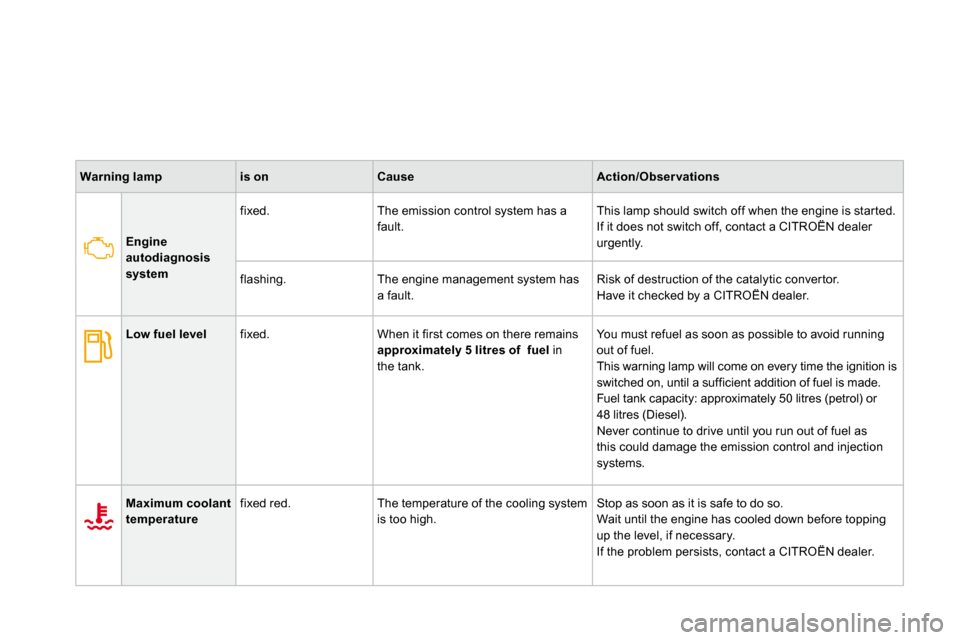
Warning lampis onCauseAction/Obser vations
Engine autodiagnosis system
fixed. The emission control system has a
fault.
This lamp should switch off when the engine is star ted.
If it does not switch off, contact a CITROËN dealer urgently.
flashing. The engine management system has a fault. Risk of destruction of the catalytic conver tor. Have it checked by a CITROËN dealer.
Low fuel level fixed. When it first comes on there remains approximately 5 litres of fuel in the tank.
You must refuel as soon as possible to avoid running out of fuel. This warning lamp will come on every time the ignition is switched on, until a sufficient addition of fuel is made. Fuel tank capacity: approximately 50 litres (petrol ) or 48 litres (Diesel). Never continue to drive until you run out of fuel a s this could damage the emission control and injection systems.
Maximum coolant temperature fixed red. The temperature of the cooling system is too high. Stop as soon as it is safe to do so. Wait until the engine has cooled down before topping
up the level, if necessary. If the problem persists, contact a CITROËN dealer.
Page 25 of 244
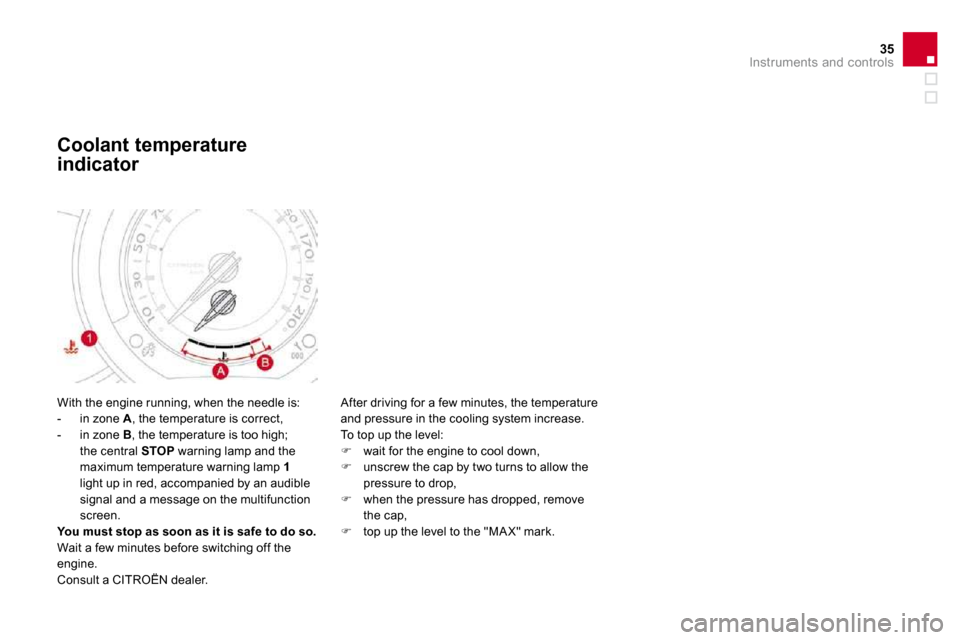
35Instruments and controls
With the engine running, when the needle is: - in zone A , the temperature is correct,
- in zone B , the temperature is too high; the central STOP warning lamp and the maximum temperature warning lamp 1light up in red, accompanied by an audible signal and a message on the multifunction screen. You must stop as soon as it is safe to do so. Wait a few minutes before switching off the engine. Consult a CITROËN dealer.
Coolant temperature
indicator
After driving for a few minutes, the temperature and pressure in the cooling system increase.
To top up the level: � wait for the engine to cool down, � unscrew the cap by two turns to allow the pressure to drop, � when the pressure has dropped, remove the cap, � top up the level to the "MA X" mark.
Page 43 of 244
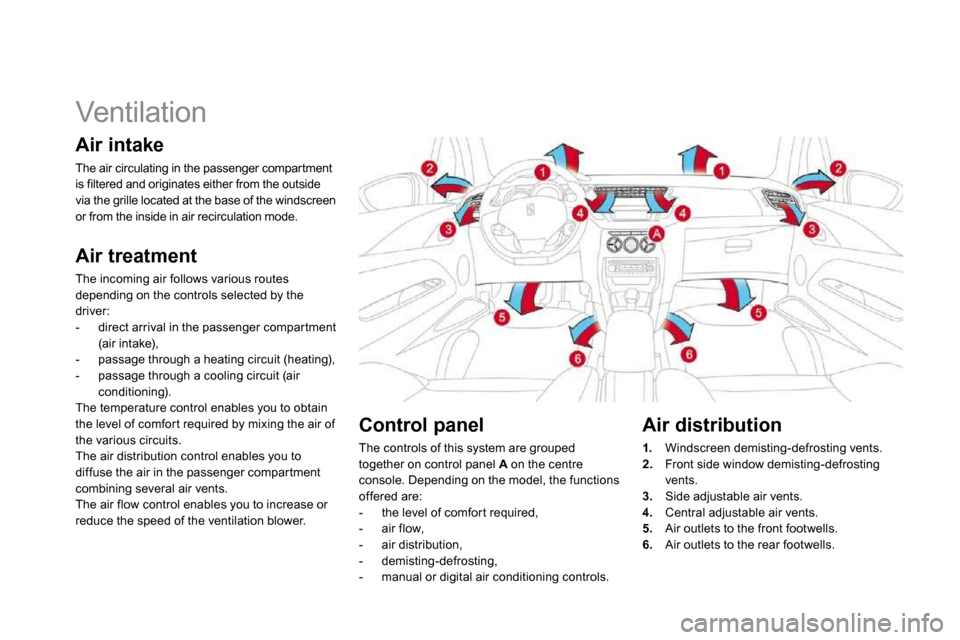
Ventilation
Air intake
The air circulating in the passenger compartment is filtered and originates either from the outside via the grille located at the base of the windscreen or from the inside in air recirculation mode.
Air treatment
The incoming air follows various routes depending on the controls selected by the driver: - direct arrival in the passenger compar tment (air intake), - passage through a heating circuit (heating), - passage through a cooling circuit (air conditioning). The temperature control enables you to obtain the level of comfor t required by mixing the air of the various circuits. The air distribution control enables you to diffuse the air in the passenger compar tment combining several air vents. The air flow control enables you to increase or reduce the speed of the ventilation blower.
Control panel
The controls of this system are grouped together on control panel A on the centre console. Depending on the model, the functions offered are: - the level of comfor t required, - air flow, - air distribution, - demisting-defrosting, - manual or digital air conditioning controls.
Air distribution
1. Windscreen demisting-defrosting vents. 2. Front side window demisting-defrosting vents. 3. Side adjustable air vents. 4. Central adjustable air vents. 5. Air outlets to the front footwells. 6. Air outlets to the rear footwells.
Page 58 of 244
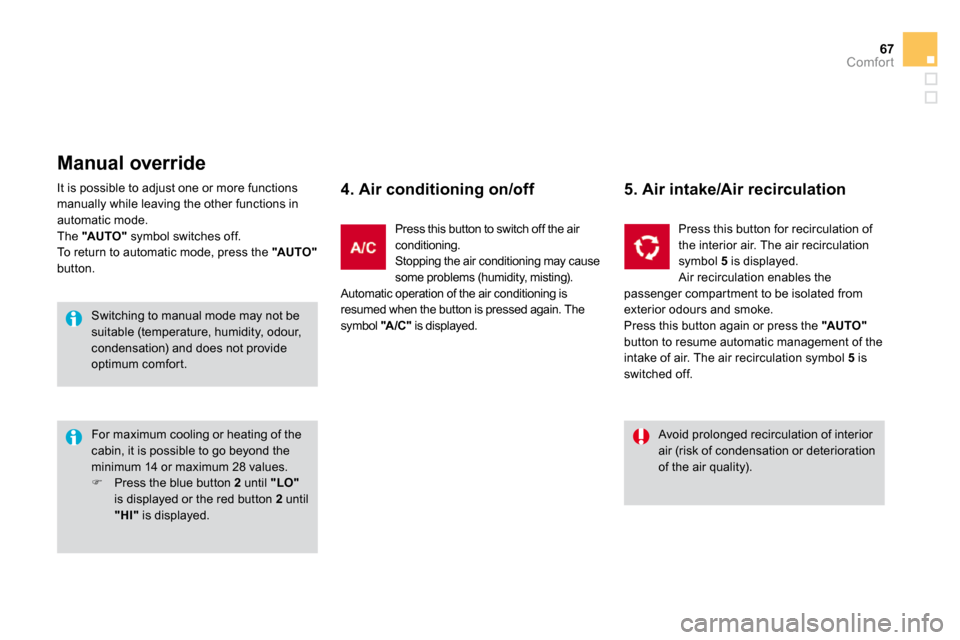
67Comfort
It is possible to adjust one or more functions manually while leaving the other functions in automatic mode.
The "AUTO" symbol switches off. To return to automatic mode, press the "AUTO"button.
� � �M�a�n�u�a�l� �o�v�e�r�r�i�d�e�
4. Air conditioning on/off
For maximum cooling or heating of the cabin, it is possible to go beyond the minimum 14 or maximum 28 values. � Press the blue button 2 until "LO"is displayed or the red button 2 until "HI" is displayed.
Press this button to switch off the air conditioning. Stopping the air conditioning may cause some problems (humidity, misting). Automatic operation of the air conditioning is resumed when the button is pressed again. The symbol "A/C" is displayed.
5. Air intake/Air recirculation
Press this button for recirculation of the interior air. The air recirculation symbol 5 is displayed. Air recirculation enables the passenger compar tment to be isolated from exterior odours and smoke. Press this button again or press the "AUTO"button to resume automatic management of the intake of air. The air recirculation symbol 5 is switched off.
Avoid prolonged recirculation of interior air (risk of condensation or deterioration of the air quality).
Switching to manual mode may not be suitable (temperature, humidity, odour, condensation) and does not provide optimum comfor t.
Page 155 of 244
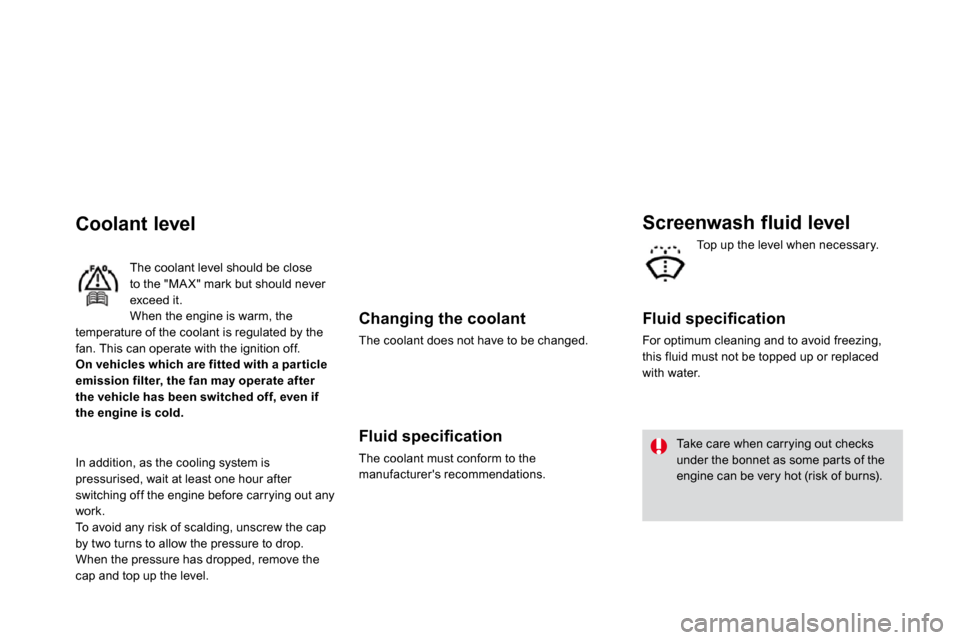
Changing the coolant
The coolant does not have to be changed.
� � �F�l�u�i�d� �s�p�e�c�i�fi� �c�a�t�i�o�n�
The coolant must conform to the manufacturer's recommendations.
Screenwash fluid level
� � �F�l�u�i�d� �s�p�e�c�i�fi� �c�a�t�i�o�n�
For optimum cleaning and to avoid freezing, this fluid must not be topped up or replaced with water.
Take care when carrying out checks under the bonnet as some par ts of the engine can be very hot (risk of burns).
Coolant level
Top up the level when necessary.
The coolant level should be close to the "MA X" mark but should never exceed it. When the engine is warm, the temperature of the coolant is regulated by the fan. This can operate with the ignition off. On vehicles which are fitted with a par ticle emission filter, the fan may operate after the vehicle has been switched off, even if the engine is cold.
In addition, as the cooling system is pressurised, wait at least one hour after switching off the engine before carrying out any work. To avoid any risk of scalding, unscrew the cap
by two turns to allow the pressure to drop. When the pressure has dropped, remove the cap and top up the level.
Page 181 of 244
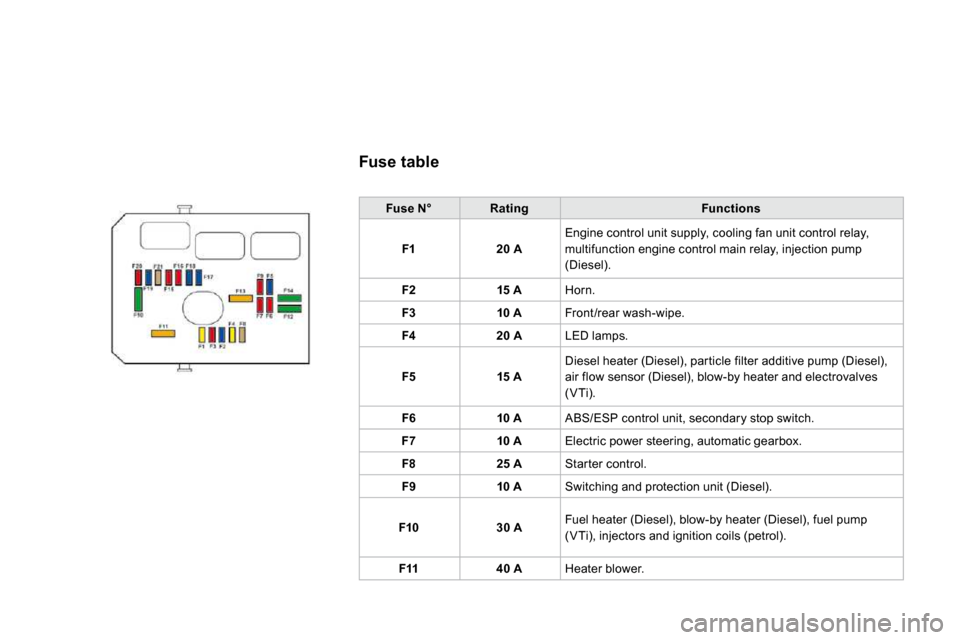
Fuse table
Fuse N°RatingFunctions
F120 A Engine control unit supply, cooling fan unit control relay, multifunction engine control main relay, injection pump (Diesel).
F215 A Horn.
F310 A Front /rear wash-wipe.
F420 A LED lamps.
F515 A Diesel heater (Diesel), par ticle filter additive pum p (Diesel), air flow sensor (Diesel), blow-by heater and electroval ves (VTi).
F610 A ABS/ESP control unit, secondary stop switch.
F710 A Electric power steering, automatic gearbox.
F825 A Star ter control.
F910 A Switching and protection unit (Diesel).
F1030 A Fuel heater (Diesel), blow-by heater (Diesel), fuel pump (VTi), injectors and ignition coils (petrol).
F1140 A Heater blower.
Page 183 of 244
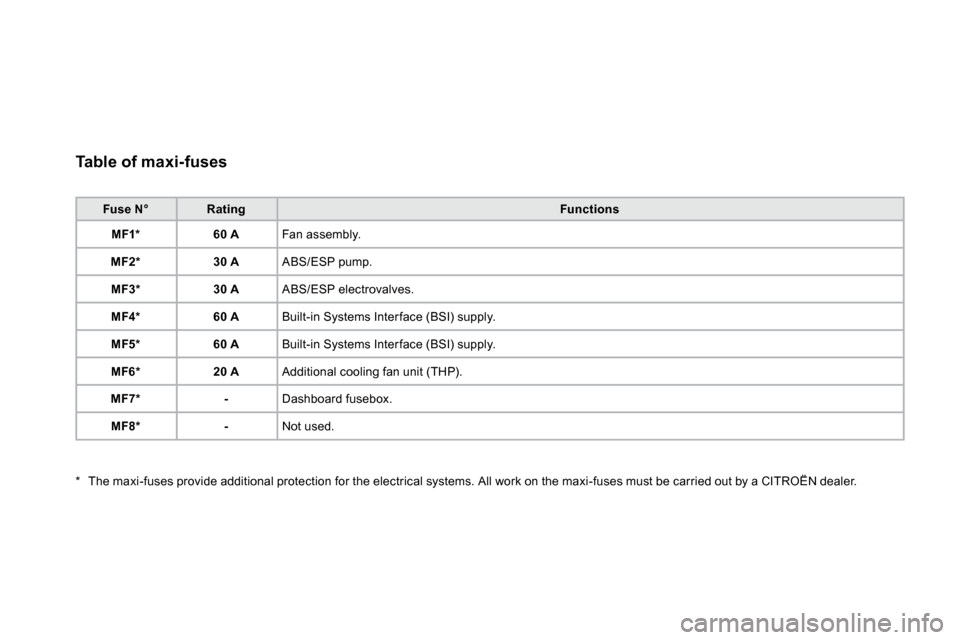
Table of maxi-fuses
Fuse N°RatingFunctions
MF1 * 60 A Fan assembly.
MF2 * 30 A ABS/ESP pump.
MF3 * 30 A ABS/ESP electrovalves.
MF4 * 60 A Built-in Systems Inter face (BSI) supply.
MF5 * 60 A Built-in Systems Inter face (BSI) supply.
MF6 * 20 A Additional cooling fan unit (THP).
MF7 * - Dashboard fusebox.
MF8 * - Not used.
* The maxi-fuses provide additional protection for the electrical systems. All work on the maxi-fuses m ust be carried out by a CITROËN dealer.
Page 190 of 244
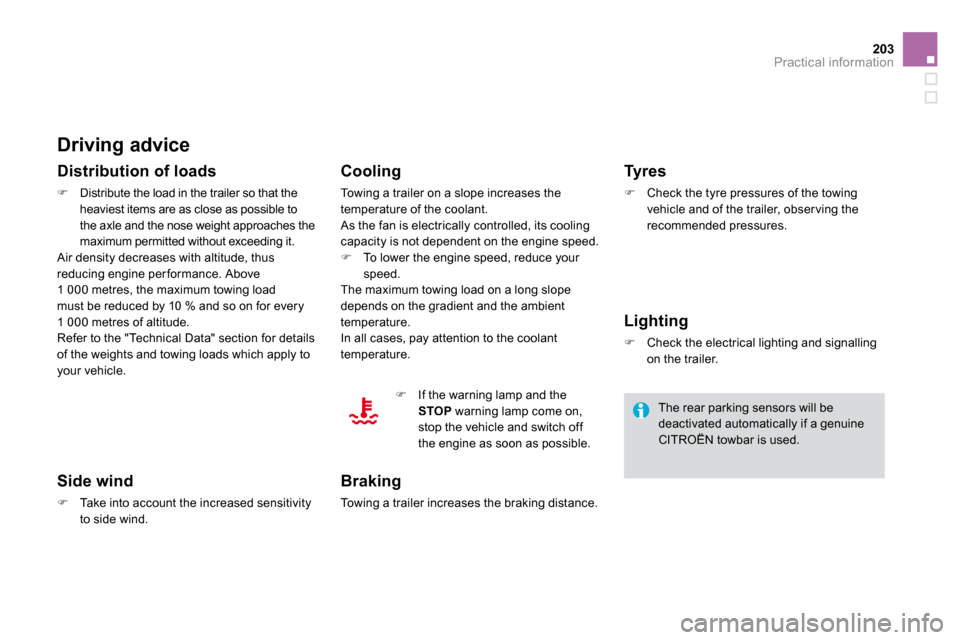
203Practical information
The rear parking sensors will be deactivated automatically if a genuine
CITROËN towbar is used.
Driving advice
Distribution of loads
� Distribute the load in the trailer so that the heaviest items are as close as possible to the axle and the nose weight approaches the maximum permitted without exceeding it. Air density decreases with altitude, thus reducing engine per formance. Above 1 000 metres, the maximum towing load must be reduced by 10 % and so on for every 1 000 metres of altitude. Refer to the "Technical Data" section for details of the weights and towing loads which apply to your vehicle.
Side wind
� Take into account the increased sensitivity to side wind.
Cooling
Towing a trailer on a slope increases the temperature of the coolant. As the fan is electrically controlled, its cooling capacity is not dependent on the engine speed. � To lower the engine speed, reduce your speed. The maximum towing load on a long slope depends on the gradient and the ambient temperature. In all cases, pay attention to the coolant temperature.
Braking
Towing a trailer increases the braking distance.
Tyres
� Check the tyre pressures of the towing vehicle and of the trailer, obser ving the recommended pressures.
Lighting
� Check the electrical lighting and signalling on the trailer.
� If the warning lamp and the STOP warning lamp come on, stop the vehicle and switch off
the engine as soon as possible.